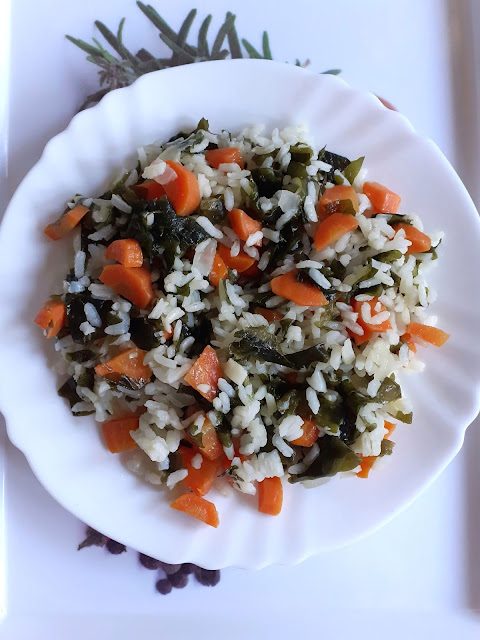Há uns meses vi (no Aldi, salvo erro) uma embalagem com algas wakame desidratadas. Nunca tinha experimentado cozinhar com algas, embora não sejam incomuns no mercado.
Pois bem, decidi experimentar as algas num arroz de cenoura e ficou delicioso!
As algas wakame têm um sabor muito interessante: é como se estivesse ali um vegetal de folha verde, mas com um toque mais marítimo.
A receita é muito simples:
Ingredientes:
1 cebola pequena
2 dentes de alho
Azeite qb
2 chávenas de água
1 chávena de arroz
3 cenouras
10g (aprox) de algas wakame desidratadas
Sal qb
 |
| Algas wakame já reidratadas |
Preparação:
Colocar as algas wakame desidratadas numa taça e colocar água até cobri-las - desta forma vão reidratar sem depois retirar água ao arroz durante a cozedura.
Num tacho, colocar azeite, cebola e alho e refogar ligeiramente.
Acrescentar água, colocar as cenouras descascadas e cortadas (gosto de cortar de forma a que as rodelas fiquem em metades ou quartos), e esperar que a água ferva.
Quando estiver a ferver, acrescentar o arroz, as algas wakame e o sal. Misturar.
Deixar levantar fervura novamente, misturar e provar o sal. Retificar, se necessário.
Cozinhar, em lume brando, sem cobrir o tacho na totalidade (para evitar que crie espuma e um potencial desastre).
Servir como acompanhamento de carne, peixe ou de um prato vegan.
******************************
ENGLISH
Some time ago while shopping at Aldi (if I am not mistaken) I noticed they were selling some nice packages of dehidrated wakame seaweed. I never tried seaweed when cooking, even though it is not something uncommon in the market.
So I decided to try wakame in rice, and it turned out delicious!
Wakame seaweed have a very interesting flavour: it's like you have another leafy vegetable in there, but with a "sea taste".
This is a very simple rice recipe:
Ingredients:
1 small onion
2 cloves of garlic
Extra virgin olive oil
2 cups of water
1 cup of rice
3 carrots
10g (aprox) of wakame seaweed
Pinch of salt
Instructions:
In a bowl, put 10g of dehidrated wakame seaweed and cover them with water - they'll absorb the water and won't "steal" it to the rice when cooking.
In a pan, braise onion and garlic with olive oil.
Add water, the carrots (peeled and cut into halved or quartered slices), and bring it to a boil. Then, add the rice, the previosly rehidrated seaweed and a pinch of salt. Stir.
Bring it to a boil once again, stir, and taste the water to check the salt. Add some more, if needed.
Cook in low heat, and position the lid in a way that doesn't cover the pot completely (to avoid the formation of foam and a potential disaster).
Serve as a side dish for a meat, fish or vegan dish.
























